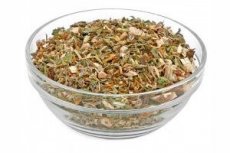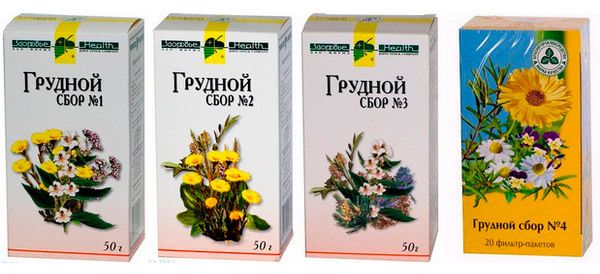Medical expert of the article
New publications
Preparations
Cough medicine
Last reviewed: 04.07.2025

All iLive content is medically reviewed or fact checked to ensure as much factual accuracy as possible.
We have strict sourcing guidelines and only link to reputable media sites, academic research institutions and, whenever possible, medically peer reviewed studies. Note that the numbers in parentheses ([1], [2], etc.) are clickable links to these studies.
If you feel that any of our content is inaccurate, out-of-date, or otherwise questionable, please select it and press Ctrl + Enter.

Diseases of the lower and upper respiratory tract are often treated with a variety of medicinal herbs. To simplify their use and make it more convenient, a ready-made chest collection for coughs was created.
The use of these drugs reduces the intensity of inflammation caused by the disease, helps to thin the sputum, expectorate it, and also makes the process of its removal easier. In addition, under the influence of the chest collection, the bronchi expand and the smooth respiratory muscles relax - a bronchodilator effect is achieved.
Does breast tea help with cough?
Often, a cough occurs after hypothermia and is a sign of influenza or acute respiratory viral infection. To prevent such a cough from becoming paroxysmal or chronic, you should start treatment in time. This will prevent the inflammation from spreading to the lungs and bronchi.
Using a chest collection for cough helps reduce irritation of the mucous membrane. In order for the treatment to be more effective, several collections should be used at once.
Although breast infusions act more slowly than medications, they have an undeniable advantage - unlike pharmaceuticals containing synthesized chemical compounds, natural herbs will not have a negative effect on the body. The plants included in herbal breast infusions are divided into several types according to their effect:
- antitussives (calendula, licorice root, as well as marshmallow root, plantain leaves, coltsfoot);
- disinfectants (yarrow, sage herb, as well as eucalyptus and mint leaves);
- replenishing vitamin deficiency (hawthorn and rose hips, raspberries with blueberries, and also black currants).
Indications for use
There are 4 types of chest cough infusions, the difference between which is as follows - they contain different medicinal components. These preparations are intended for the treatment of the following diseases:
- Acute, obstructive and chronic bronchitis, as well as bronchial asthma;
- Tracheitis and tracheobronchitis, as well as laryngitis or pharyngitis;
- Chronic obstructive pulmonary disease or pneumonia;
- Tuberculosis;
- Flu, acute respiratory viral infections or other illnesses that involve expectoration.
 [ 7 ]
[ 7 ]
Release form
The release form of antitussive chest collections: packs with herbal collection or tea filter bags.
Herbal chest collection is a mixture of various herbs that is used to make a tincture or decoction that helps treat coughs. Typically, such collections consist of herbs that have antiseptic, expectorant, and mucolytic effects.
All breast collections from manufacturers have numbers, in accordance with the composition and proportions of herbs. Such a mixture of different types of medicinal plants is placed in a paper bag and then in a cardboard box. It is better to store such herbal collection in dry dishes (ceramic or glass). Before use, the mixture should be stirred.
Pharmacodynamics
Among the components of the collection are flavonoids, carotenoids, various organic acids, and saponins. In addition, it contains tannins, various vitamins and coumarins. This combination of active biocomponents has an effective anti-inflammatory and expectorant effect, and a dry cough is softened. The collection activates the activity of the ciliated epithelium of the respiratory organs, promoting the liquefaction of the sputum that has appeared and its subsequent expectoration from the bronchi.
Breast collection for dry cough
If you have an obsessive dry cough, you can use chest collection No. 1, as its components have a good anti-inflammatory and bactericidal effect. This allows you to protect the mucous membranes of the respiratory tract, reducing their irritation, as a result of which the urge to cough will also decrease.
In some cases, for dry cough, it is recommended to use the 1st and 2nd collections at the same time - mix both preparations in equal quantities.
Breast collection for wet cough
If you have a wet cough with expectoration of phlegm, you need to speed up its discharge. It is known that the urge to cough is a natural reaction of the body to an irritant. Due to the resulting jerky spasms in the bronchi, the mucus in them comes out. To speed up this process, chest collections No. 2 and No. 4 are used.
Tea chest collection
The chest collection in the form of tea is sold in special filter bags that look like tea bags. They are very convenient to brew, because after that they do not need to be filtered additionally.
Composition of the chest collection for cough
The composition of chest collection for cough No. 1 is oregano, pine buds, plantain, sage, and black elderberry blossom.
The composition of chest collection No. 2: licorice root, coltsfoot, plantain.
Breast collection No. 3 contains birch buds, anise, as well as marshmallow and elecampane roots.
Collection No. 4 contains chamomile, wild pansy, calendula, licorice root, peppermint, and wild rosemary.
Breast collection 1
The main property of this collection is its antiseptic effect. Medicinal decoctions or tinctures are prepared from it. Chest collection No. 1 should be used to treat inflammatory or infectious diseases of the respiratory tract, which are accompanied by a cough.
Breast collection 2
Licorice root helps eliminate inflammation and reduce cough intensity. Plantain is also very effective in combating inflammation. Therefore, in combination, these medicinal herbs have a bronchodilating effect - they help relax the smooth muscles of the bronchi, thereby reducing swelling of the mucous membrane.
Breast collection 3
Breast collection 3 causes an expectorant effect, and also has an anti-inflammatory effect. The herbs included in the medicine have a significant anti-inflammatory effect, facilitating the process of sputum discharge.
Breast collection 4
For dry cough, chest collection 4 is often prescribed, since under the influence of wild rosemary, the cough is transformed from dry to wet, and this significantly alleviates the patient's condition. Inflammation is relieved thanks to calendula and violet (it also has a sedative effect).
The properties of pectoral infusions are examined in detail using the example of preparation No. 4.

 [ 24 ]
[ 24 ]
Breast collection for children against cough
When selecting a breast collection for cough for children, you should take into account the child's age, as well as the presence of concomitant diseases. For children aged one year and older, compositions containing a minimum of components are suitable. At an older age, it is already allowed to use breast collections No. 3 and No. 4 (if the child is not allergic to the components of the drug).
It should be remembered that the composition of chest collection No. 4 includes wild rosemary, therefore after taking this medicine the patient may experience irritability, headaches and dizziness. So you need to approach the use of this collection with caution, not exceeding the prescribed dose.
A child under 1 year old should not be given breast tea. It is better to brew one of the plants contained in it - for example, thyme herb, licorice root or chamomile decoction.
Children under 3 years old are prescribed 1 tablespoon of decoction four times a day. For ages 3-10, the number of spoons increases to 2, and the number of doses remains the same.
Children aged 10+ can take 1/3 glass three times a day.
 [ 25 ], [ 26 ], [ 27 ], [ 28 ]
[ 25 ], [ 26 ], [ 27 ], [ 28 ]
Method of administration and dosage
Method of use, as well as recommended dosages of collection No. 1. Take 1 tbsp. of the mixture, pour 1 glass of cold water, then keep the tincture in a water bath for 15 minutes. Then leave to infuse for about 45 minutes, then strain and bring the volume of the prepared tincture to 200 ml. Drink it 2-3 times a day, 100 ml after meals. For children, the amount of the herbal mixture is halved. The treatment course lasts about 2-3 weeks.
Breast collection No. 2 is prepared according to the same scheme as the first. The medicine should be taken 3-4 times a day, 100 ml each. The tincture should be warm, shaken before taking. The entire course of treatment also lasts for 2-3 weeks.
Breast collection No. 3 is prepared in the same way, but you need to take not one, but 2 tablespoons of herbal mixture. The dosage and number of doses are the same as for collection No. 2. The treatment course is the same 2-3 weeks.
Collection No. 4 is prepared according to the same scheme and in the same quantity as collection No. 3, the treatment course is 2-3 weeks. The tincture should be consumed 70 ml 3-4 times a day.
Use during pregnancy
It is not recommended to use breast collection during pregnancy, because all these preparations contain components that are contraindicated for pregnant women. Medicinal collection No. 1 contains oregano, collections No. 2 and No. 4 contain licorice root, which disrupts hormonal balance, causes tachycardia, increases nervousness, and increases the risk of developing edema. In addition, it can cause headaches. Collection No. 3 contains anise, which is prohibited during pregnancy.
Contraindications for use and side effects
A pectoral collection of medicinal herbs may be contraindicated in case of individual hypersensitivity to the components of this medicine.
Side effects mainly occur in patients with individual hypersensitivity to the drug. Among the effects, allergy is usually observed, which manifests itself in the form of urticaria, allergic rhinitis, as well as skin rash, swelling or itching.
Overdose and interactions with other drugs
If an overdose occurs, symptoms of intoxication may occur. If chest collection No. 4 was used, the poisoning will most likely be associated with wild rosemary, since this herb is considered poisonous.
It is not recommended to use breast infusions in combination with antitussive drugs and drugs that reduce the expectoration of sputum - this is due to the fact that as a result, the process of coughing up liquefied sputum by the patient becomes difficult.
Storage conditions and shelf life
Breast infusions should be kept in a dry place, protected from sunlight. And the prepared tincture can be stored for a maximum of 2 days in a cool place, such as a refrigerator.
The chest collection for cough is allowed to be used for 2 years. The expiration date is indicated on the package.
Attention!
To simplify the perception of information, this instruction for use of the drug "Cough medicine" translated and presented in a special form on the basis of the official instructions for medical use of the drug. Before use read the annotation that came directly to medicines.
Description provided for informational purposes and is not a guide to self-healing. The need for this drug, the purpose of the treatment regimen, methods and dose of the drug is determined solely by the attending physician. Self-medication is dangerous for your health.

